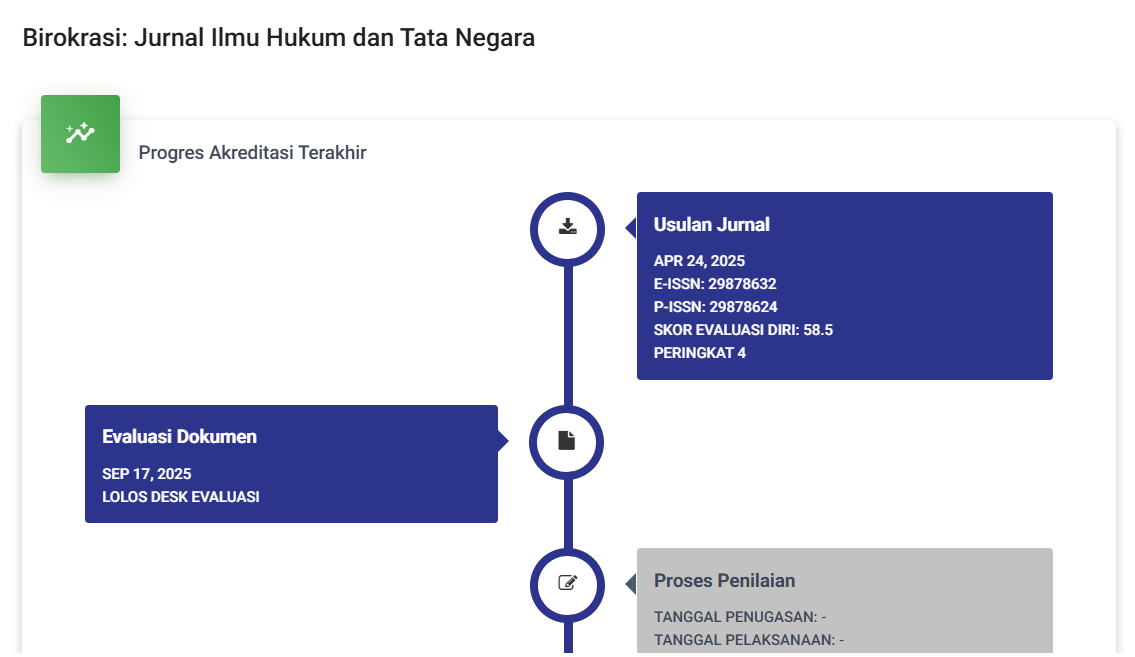Evaluasi Pemanfaatan Ruang Terbuka Hijau Taman Tanjung Puri Sesuai Dengan Rencana Tata Ruang Kabupaten Sidoarjo
DOI:
https://doi.org/10.55606/birokrasi.v2i3.1297Keywords:
Green Open Space, Green Space Utilization, Spatial Planning, Sidoarjo DistrictAbstract
Green open space (RTH) utilization is an important part of spatial planning in Sidoarjo Regency. In urban ecosystems, public green spaces are open areas designed for recreation, nature conservation and greening in urban environments. According to Local Regulation No. 6/2009 on the 2009-2029 Sidoarjo District Spatial Plan (RTRW), public green open space (RTH) is designed for recreation, nature conservation and greening. RTH is an important component of Sidoarjo District's spatial planning, especially in urban ecosystems The purpose of this research is to evaluate the level of compliance of RTH utilization in Tanjung Puri Park with the provisions of Sidoarjo District Spatial Plan No. 6/2009. This evaluation was conducted to support sustainable development in Sidoarjo Regency.The results of this study provide the fact that, Green Open Space (RTH) Taman Tanjung Puri does not meet the standards of the Sidoarjo Regency Spatial Plan properly. This is due to the type of green space and its function not in accordance with the plan, as well as the lack of infrastructure and facilities. On the other hand, Tanjung Puri Park is still underutilized as a public space. This situation is also caused by a lack of budget, management facilities and infrastructure, poor public understanding of the park's existence and purpose, and low community involvement. The conclusion obtained in this study is that the potential of Tanjung Puri Park as a public space is hampered by a lack of planning. Taman Tanjung Puri has great potential to provide various environmental, social, and economic benefits, but it’s utilization has not been optimal due to the lack of supporting facilities, inconsistent maintenance, low community participation, and fragmented management being the inhibiting factors.
References
Ali, A.A., et al. (2022). Evaluasi Pemanfaatan Ruang Terbuka Hijau Publik di Kecamatan Baolan Kabupaten Tolitoli. 10(1), 35–42.
Almeida, C.S., et al. (2016). Penerapan Infrastruktur Hijau Di Berbagai Negara. In Revista Brasileira de Linguística Aplicada 5(1).
Andreia, D., & Bella, P. A. (2023). Evaluasi Ruang Terbuka Hijau Pada Taman Kota Waduk Pluit, Jakarta Utara. Jurnal Sains, Teknologi, Urban, Perancangan, Arsitektur (Stuipa), 5(1), 445–456. https://doi.org/10.24912/stuipa.v5i1.22700
Hasbi, I., et al (2021). Buikui Kebijakan Publik (Issue juli).
Karim, R.N., Saronsong, F.B., & Kalangi, J. (2021). Evaluasi Pemanfaatan Ruang Terbuka Hijau Taman Nukila Kota Ternate Evaluation of Green Open Space Utilization At Nukila Park Ternate City. Agri SosioEkonomi, 17(3), 901–908. https://doi.org/10.35791/agrsosek.17.3.2021.37240
Mashur, D., & Rusli, Z. (2018). Upaya Dan Implikasi Penyediaan Ruang Terbuka Hijau (Rth). Jurnal Kebijakan Publik, 9(1), 45. https://doi.org/10.31258/jkp.9.1.p.45-52
Nuryanto, H.M., et al (2023). ANALISIS KETENTUAN PERANCANGAN TATA RUANG WILAYAH YANG BAIK BERDASARKAN UNDANG-UNDANG NOMOR 26 TAHUN 2007 8(1), 96–110.
Wardani, B.K., & Ekasari, A.M. (2022). Kajian Evaluasi Manfaat Pembangunan Taman Kiara Artha Terhadap Pengunjung dan Pelaku Usaha. Jurnal Perencanaan Wilayah Dan Kota, 17(1), 10–25. https://doi.org/10.29313/jpwk.v17i1.593








